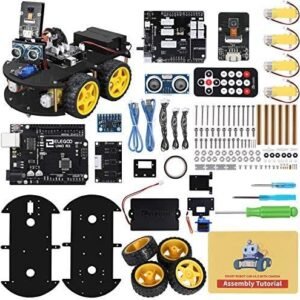The automotive landscape is undergoing a profound transformation, fueled by remarkable advancements in artificial intelligence (AI). As we stand on the brink of a new era in mobility, the integration of AI technologies is redefining the capabilities of autonomous vehicles, making them smarter, safer, and more efficient than ever before. From advanced perception systems that enable vehicles to navigate complex environments, to machine learning algorithms that enhance decision-making processes, AI innovations are at the heart of this evolution. In this article, we delve into the cutting-edge technologies propelling autonomous vehicles into the mainstream, exploring how AI is not just a tool, but a game-changer in the quest for self-driving solutions. Join us as we unpack the latest breakthroughs and examine the implications of these innovations for the future of transportation.
Table of Contents
- Understanding the Core Technologies Behind Autonomous Vehicle Innovation
- Examining the Role of Machine Learning in Enhancing Safety and Efficiency
- Evaluating the Impact of AI-Driven Sensor Fusion on Navigation Accuracy
- Recommendations for Stakeholders in the Autonomous Vehicle Ecosystem
- Future Outlook
Understanding the Core Technologies Behind Autonomous Vehicle Innovation
At the heart of autonomous vehicle innovation lies a complex interplay of cutting-edge technologies that work in unison to enhance driving safety and efficiency. Artificial Intelligence (AI) serves as the backbone of these systems, utilizing machine learning algorithms to analyze vast amounts of data in real time. The AI models are trained on diverse datasets to recognize patterns in the environment, enabling vehicles to comprehend and respond to various road conditions, surrounding traffic, and obstacles. Additionally, advanced computer vision enables the vehicles to interpret visual information through cameras and sensors, creating a detailed map of the world around them. Key technologies include:
- LiDAR (Light Detection and Ranging): Uses laser beams to generate precise 3D maps of surroundings.
- Radar: Employs radio waves to detect the speed and distance of surrounding objects.
- GPS: Facilitates accurate vehicle positioning and navigation in real-time.
Another critical component is the Vehicle-to-Everything (V2X) communication system, which allows vehicles to communicate with each other and infrastructure elements such as traffic lights and road signs. This technology enhances situational awareness and improves decision-making processes in automated driving scenarios. As vehicles become more interconnected, the potential for traffic optimization and accident reduction increases significantly. To illustrate the interplay of these technologies, consider the table below, which highlights their contributions to autonomous vehicle capabilities:
| Technology | Function | Benefits |
|---|---|---|
| AI Algorithms | Data analysis and decision-making | Enhanced safety and efficiency |
| Computer Vision | Environment perception | Real-time obstacle detection |
| V2X Communication | Inter-vehicle communication | Improved traffic flow and response |
Examining the Role of Machine Learning in Enhancing Safety and Efficiency
In the rapidly evolving landscape of autonomous vehicles, machine learning plays a pivotal role in both enhancing safety and optimizing efficiency. By leveraging vast amounts of data from various sensors, vehicles equipped with machine learning algorithms can interpret their surroundings in real-time. This capability enables them to make informed decisions that prioritize passenger safety while minimizing risks associated with human error. Key methodologies that contribute to these advancements include:
- Deep Learning: Enhances image processing for object recognition.
- Reinforcement Learning: Allows vehicles to learn from experiences and improve navigation.
- Predictive Analytics: Forecasts traffic patterns to optimize routes and reduce delays.
The efficiency of autonomous vehicles is not solely defined by their operational capabilities but also by their interaction with complex environments. Machine learning allows these vehicles to adapt and learn from both static and dynamic elements, such as road conditions and pedestrian behavior. A well-designed feedback loop enhances their ability to learn from each trip, ensuring that every journey contributes to improved algorithms. Here’s a brief look at how specific machine learning techniques enhance different aspects of autonomous driving:
| Technique | Enhancement Aspect | Benefit |
|---|---|---|
| Computer Vision | Object Detection | Improved safety through accurate identification of obstacles |
| Natural Language Processing | Voice Commands | Enhanced user experience with intuitive controls |
| Clustering Algorithms | Traffic Pattern Analysis | Increased efficiency by predicting and avoiding congested routes |
Evaluating the Impact of AI-Driven Sensor Fusion on Navigation Accuracy
AI-driven sensor fusion technologies have significantly refined the navigation systems within autonomous vehicles, enhancing their accuracy in real-time environments. By integrating data from various sensors, such as LIDAR, radar, and cameras, AI algorithms can process complex data sets to produce a cohesive and precise understanding of surroundings. This capability allows autonomous vehicles to:
- Dramatically reduce localization errors by comparing sensor data against high-definition maps.
- Adapt to dynamic environments by continuously updating navigation paths using machine learning techniques.
- Improve obstacle detection through 360-degree awareness, thereby preventing potential accidents.
To properly gauge the advancements in navigation accuracy brought by these technologies, it’s essential to analyze effectiveness across different scenarios. The following table illustrates a comparison of traditional versus AI-enhanced sensor fusion techniques:
| Technique | Accuracy Level | Processing Speed | Cost Efficiency |
|---|---|---|---|
| Traditional Methods | Moderate | Slower | High |
| AI-Driven Sensor Fusion | High | Faster | Lower |
These insights underscore the transformative role AI and sensor fusion play in enhancing navigation systems, driving the future of autonomous technology closer to reality.
Recommendations for Stakeholders in the Autonomous Vehicle Ecosystem
In order to foster a thriving ecosystem for autonomous vehicle technology, it is imperative for stakeholders to collaborate effectively and prioritize shared objectives. Governments should focus on creating comprehensive regulatory frameworks that not only ensure safety but also stimulate innovation. Meanwhile, automakers must invest in research and development that integrates cutting-edge AI advancements while partnering with tech firms to leverage software expertise. Additionally, insurance companies should adapt their policies to reflect the nuances of autonomous systems, offering flexible coverage tailored to evolving risks associated with self-driving vehicles.
Moreover, key players in the autonomous vehicle ecosystem should engage in continuous dialog with the public to build trust and acceptance. Public awareness campaigns can highlight the benefits of this technology while addressing concerns about safety and privacy. Infrastructure providers need to prioritize updating existing roadways and traffic systems to better accommodate autonomous vehicles. A joint effort in data sharing among stakeholders will also enhance machine learning algorithms, driving improvements in vehicle performance and overall safety. The table below illustrates a few critical areas for stakeholder collaboration:
| Stakeholder | Focus Area |
|---|---|
| Governments | Regulatory Frameworks |
| Automakers | R&D Investments |
| Insurance Companies | Adaptive Policies |
| Infrastructure Providers | Roadway Adaptation |
| Public Engagement | Acknowledging Concerns |
Future Outlook
As we stand on the brink of a transformative era in transportation, the innovations shaping autonomous vehicle technology are nothing short of remarkable. The integration of artificial intelligence not only enhances the safety and efficiency of our roads but also reshapes our understanding of mobility itself. From advanced sensors and machine learning algorithms to sophisticated data processing capabilities, these innovations are driving us towards a future where autonomous vehicles will become an integral part of our everyday lives.
As we continue to explore and embrace these advancements, it is essential to consider both the opportunities and challenges they present. Regulatory frameworks, ethical considerations, and public acceptance will play critical roles in the successful adoption of this technology. The road ahead may be complex, but the potential for a safer, more efficient, and environmentally sustainable transportation system is within our reach.
Thank you for joining us on this journey into the world of AI innovations in autonomous vehicle technology. Stay tuned for more insights and updates, as we continue to track the developments that are paving the way for a new era in mobility. The future is here, and it promises to be exciting!





